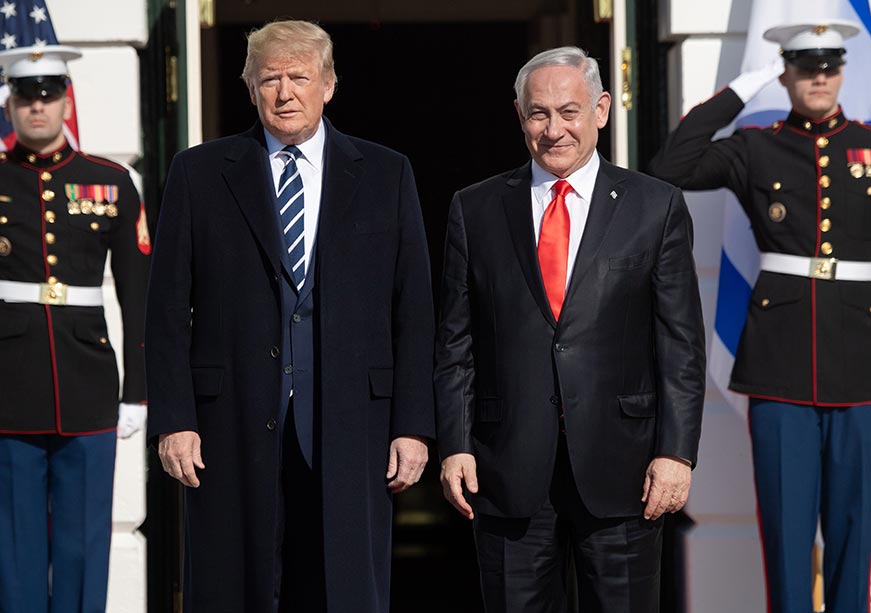-
CENTRES
Progammes & Centres
Location
Trump doubles down on pro-Israel policies, but at what cost? His Middle East ambitions hinge on regional stability. Will prioritising Israel hinder or help?

Image Source: Getty
While United States (US) President Donald Trump was expected to adopt a more realistic stance on Israel in his second term, he has instead doubled down on his pro-Israel position. However, this time, it comes at a greater cost: one of his key priorities will be fostering regional stability in the war-torn Middle East through economic initiatives and ‘mega deals’. Trump’s big-ticket focus this term appears to be Saudi Arabia, with a potential US$600 billion deal in the works between both countries. Additionally, the kingdom is emerging as a key diplomatic hub for the ongoing US-Russia talks. However, Saudi Arabia’s and several other Gulf States’ deepening opposition to Israel and blatant rejection of Trump’s proposed Gaza plans is a major obstacle. The key question for Trump 2.0’s Middle East agenda, therefore, is whether bolstering Israel’s position will once again be its central focus, as in his first term, or if Trump will leverage Israel to advance broader regional goals, such as business collaborations akin to the I2U2 (India, Israel, the United Arab Emirates, and the US) or large-scale connectivity projects.
It can be reasonably conjectured that pressuring Israel to abide by the ceasefire is the only realistic way Trump could bring stability to the Middle East and even possibly materialise his plans to forge a peace deal between Saudi Arabia and Israel. However, in light of their meeting in Washington, DC, in early February 2025, the dynamic between Benjamin Netanyahu and Trump has proven more fantastical than ever, pushing away key partners like Saudi Arabia, which seeks a deeper alliance with the US.
Trump’s proposal surprised even the Israeli far-right, as its severity goes above and beyond their own hardline positions.
Trump’s proposal of extreme measures, such as the mass transfer of Palestinians out of Gaza to neighbouring states followed by the US taking over the site and developing a “Riviera of the Middle East”, is unrealistic since Egypt and Jordan have refused to absorb the Palestinian population in case of such a transfer and the overwhelming financial and logistical burdens this plan brings with it. Saudi Arabia has also reaffirmed Palestinian rights and that a peace deal with Israel is unlikely to happen without a Palestinian state. Trump’s proposal surprised even the Israeli far-right, as its severity goes above and beyond their own hardline positions. Trump may also endorse Israel’s annexation of the West Bank, prioritising Israel’s regional dominance over efforts to dislodge Hamas. His approach suggests that he perceives Gaza’s very existence, not Netanyahu’s leadership or Israeli policies, as the core issue. Even if Trump believes the ceasefire deal is doomed to fail or is unsustainable, rather than pressuring Israel to proceed with the agreement (especially since Hamas has agreed to surrender power if the Israeli military fully withdraws), he proposed an unfeasible and destabilising solution: uprooting a city that has over four millennia of history—a suggestion that has been met with overwhelming opposition from other Middle Eastern nations, with Arab League states scrounging for alternatives.
The source of Netanyahu’s and Israeli Ambassador to the US Yechiel Leiter’s inflated expectations from Trump 2.0 can be traced to the latter’s aggressive support for Israeli ambitions in his first term. The most notable instance was Trump’s recognition of Jerusalem as Israel’s capital in 2017, making him the first US president to move the American embassy from Tel Aviv to Jerusalem. Further, in January 2020, Trump proposed the “Deal of the Century”, which outlined a plan for Israel to annex approximately 30 percent of the West Bank, including Israeli settlements and the Jordan Valley. The remaining 70 percent of the West Bank was designated for a future Palestinian state, contingent upon Palestinian leadership meeting certain conditions. The plan also suggested the potential transfer of some Arab-majority areas in Israel to the future Palestinian state. However, Trump’s efforts for a two-state solution have been futile on account of his failure to address the key concerns of both sides while enhancing Israel’s position in the region.
Trump’s ‘peace plan’ also included cutting off United Nations Relief and Works Agency funding in 2018, which assisted Palestinian refugees and those in occupied territories, and urging Palestinians to renew peace talks with Israel. Before this, he also temporarily froze funding from the US Agency for International Development (USAID), the majority of whose programmes were based in Gaza at the time.
According to Aaron David Miller, former Middle East adviser to several US secretaries of state, while Trump’s approach was largely aimed at pressuring Palestinians to agree to his peace plan, it was also aimed at saving Washington’s money.
The 10-year Memorandum of Understanding (MoU) between the two nations, allocating Israel US$3.3 billion annually in Foreign Military Financing, is a one-of-a-kind agreement and does not exist between the US and any other state.
Since Israel’s recognition by President Harry S. Truman in 1948, it has been the largest recipient of US foreign aid, receiving approximately US$310 billion to date. Between October 2023 and 2024, the US allocated around US$17.9 billion to Israel, making it one of the country’s most significant overseas military expenditures since 2023. The 10-year Memorandum of Understanding (MoU) between the two nations, allocating Israel US$3.3 billion annually in Foreign Military Financing, is a one-of-a-kind agreement and does not exist between the US and any other state. This MoU expires in 2028 and should trigger major reconsiderations for a financially driven Trump 2.0, for whom Israel poses a major overseas expenditure. For Trump 2.0, whose main election promise was about tackling inflation at home, reconsidering America’s financial commitments to Israel should be the logical next step, especially given his decision to pause USAID funding and major financial and transactional considerations directed at Ukraine.
One of the reasons why this should be Trump’s war is domestic inflation, which has been a key factor for his voter base. Additionally, with Trump’s tariff war on China, the latter is likely to further divert exports to the Middle East, where its trade has been bullish in recent years. A growing Russo-Chinese defence axis also reinforces the need for Trump to ensure a relatively stable Middle East to establish a counterbalance to China, and strengthening Israel’s regional position may not be a viable strategy for securing American influence in the region.
As Trump’s plans to collaborate with India on the India–Middle East–Europe Economic Corridor (IMEEC) come to light, Trump’s Middle East strategy, in hindsight, is proving to be a double-edged sword: while adding little to regional stability, it fundamentally hinders his own and allies’ ambitions—particularly India’s—for connectivity, infrastructure projects, and large-scale investments in the Gulf. IMEEC and other future connectivity projects could progress more rapidly if a business-minded Trump prioritised regional stability, given his aspirations for an increased stake in the region and deeper partnerships with India, Europe, and other Middle Eastern allies.
A growing Russo-Chinese defence axis also reinforces the need for Trump to ensure a relatively stable Middle East to establish a counterbalance to China, and strengthening Israel’s regional position may not be a viable strategy for securing American influence in the region.
While Trump is expected to craft his own Middle East business strategies, he is also likely to build on Joe Biden’s initiatives, such as the I2U2. In his first term, Trump engaged in business dealings with several Arab League states beyond Saudi Arabia—an agenda he is likely to expand this time around. If he chooses to pressure Israel into following through with a ceasefire deal, he would be better positioned to advance his broader regional ambitions with more cooperative Middle East partners on his side.
For Trump, pressuring Israel to abide by a ceasefire deal is the only realistic path to bringing stability to the Middle East and shaping a regional order aligned with his business ambitions. However, to do so, he must confront Netanyahu with the reality that Hamas is unlikely to disappear anytime soon. At the same time, countries such as Saudi Arabia, Qatar, and Jordan are increasingly open to collaborating with the US, but only if Israel follows through with the ceasefire deal.
While Israel remains a key investment base for the US in the Middle East, America now has more options for regional allies, and its unwavering support for Israel is causing hesitation among potential partners. The AI video of Trump’s ‘Gaza Plan’ may have added fuel to the fire.
In retrospect, crafting a coherent Middle East policy is becoming increasingly challenging for the Trump administration, especially following his recent decision to fast-track a nearly US$3 billion arms sale to Israel. If Trump aims to prioritise broader regional cooperation, he may need to recalibrate his approach to Israel to foster deeper strategic and economic engagements across the Middle East.
Kashvi Chaudhary is Research Intern at the Observer Research Foundation.
The views expressed above belong to the author(s). ORF research and analyses now available on Telegram! Click here to access our curated content — blogs, longforms and interviews.

Kashvi Chaudhary is a Research Intern at the Observer Research Foundation ...
Read More +